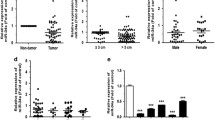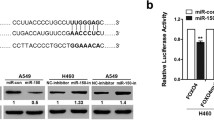Abstract
MicroRNA-145 (MiR-145) is an important regulator of tumorigenesis. Our previous work indicated that miR-145 reduced the proliferation and invasion as well as the tumorosphere growth capacity in lung adenocarcinoma cells. However, the underlying molecular mechanisms remain elusive. Here, we reported that the expression level of miR-145 was downregulated in lung adenocarcinoma tissues and negatively correlated with the expression level of Oct4. MiR-145 inhibited the proliferation of lung cancer-initiating cells (LCICs), partially by regulating Oct4 expression. Furthermore, we found that miR-145 exerted repressive effect on cancer stem cell properties and inhibited epithelial-mesenchymal transition (EMT) in vitro, also partially by regulating Oct4. Finally, we confirmed the repressive effect of miR-145 on cancer stem cell properties and EMT in vivo. Taken together, these evidences suggest that miR-145 serves as a tumor suppressor which downregulates LCICs’ cancer stem cell properties and EMT process by targeting Oct4, leading to the inhibition of tumor growth and metastasis.





Similar content being viewed by others
References
Parkin DM, Pisani P, Ferlay J. Global cancer statistics. CA Cancer J Clin. 1999;49:33–64. 1.
Lam WK, Watkins DN. Lung cancer: future directions. Respirology. 2007;12:471–7.
Crunkhorn S. Anticancer drugs: curbing self-renewal of cancer-initiating cells. Nat Rev Drug Discov. 2014;13:102.
Bertolini G, Roz L, Perego P, Tortoreto M, Fontanella E, Gatti L, et al. Highly tumorigenic lung cancer cd133+ cells display stem-like features and are spared by cisplatin treatment. Proc Natl Acad Sci U S A. 2009;106:16281–6.
Matsubara H, Takeuchi T, Nishikawa E, Yanagisawa K, Hayashita Y, Ebi H, et al. Apoptosis induction by antisense oligonucleotides against mir-17-5p and mir-20a in lung cancers overexpressing mir-17-92. Oncogene. 2007;26:6099–105.
Bartel DP. MicroRNAs: genomics, biogenesis, mechanism, and function. Cell. 2004;116:281–97.
Johnnidis JB, Harris MH, Wheeler RT, Stehling-Sun S, Lam MH, Kirak O, et al. Regulation of progenitor cell proliferation and granulocyte function by microRNA-223. Nature. 2008;451:1125–9.
Mocellin S, Pasquali S, Pilati P. Oncomirs: from tumor biology to molecularly targeted anticancer strategies. Mini Rev Med Chem. 2009;9:70–80.
Xing F, Wu K, Watabe K. MicroRNAs in cancer stem cells: new regulators of stemness. Curr Pharm Des. 2014. doi:10.2174/1381612820666140128210912.
Yu F, Deng H, Yao H, Liu Q, Su F, Song E. Mir-30 reduction maintains self-renewal and inhibits apoptosis in breast tumor-initiating cells. Oncogene. 2010;29:4194–204.
Lin S, Sun JG, Wu JB, Long HX, Zhu CH, Xiang T, et al. Aberrant microRNAs expression in cd133(+)/cd326(+) human lung adenocarcinoma initiating cells from a549. Mol Cells. 2012;33:277–83.
Cho WC, Chow AS, Au JS. Mir-145 inhibits cell proliferation of human lung adenocarcinoma by targeting egfr and nudt1. RNA Biol. 2011;8:125–31.
Lu R, Ji Z, Li X, Zhai Q, Zhao C, Jiang Z, et al. Mir-145 functions as tumor suppressor and targets two oncogenes, angpt2 and nedd9, in renal cell carcinoma. J Cancer Res Clin Oncol. 2014;140:387–97.
Yin R, Zhang S, Wu Y, Fan X, Jiang F, Zhang Z, et al. MicroRNA-145 suppresses lung adenocarcinoma-initiating cell proliferation by targeting oct4. Oncol Rep. 2011;25:1747–54.
Kalluri R, Weinberg RA. The basics of epithelial-mesenchymal transition. J Clin Invest. 2009;119:1420–8.
Thiery JP, Sleeman JP. Complex networks orchestrate epithelial-mesenchymal transitions. Nat Rev Mol Cell Biol. 2006;7:131–42.
Yang J, Weinberg RA. Epithelial-mesenchymal transition: at the crossroads of development and tumor metastasis. Dev Cell. 2008;14:818–29.
Pirozzi G, Tirino V, Camerlingo R, Franco R, La Rocca A, Liguori E, et al. Epithelial to mesenchymal transition by tgfbeta-1 induction increases stemness characteristics in primary non small cell lung cancer cell line. PLoS One. 2011;6:e21548.
Dai X, Ge J, Wang X, Qian X, Zhang C, Li X. Oct4 regulates epithelial-mesenchymal transition and its knockdown inhibits colorectal cancer cell migration and invasion. Oncol Rep. 2013;29:155–60.
Hu J, Qin K, Zhang Y, Gong J, Li N, Lv D, et al. Downregulation of transcription factor oct4 induces an epithelial-to-mesenchymal transition via enhancement of Ca2+ influx in breast cancer cells. Biochem Biophys Res Commun. 2011;411:786–91.
Eramo A, Lotti F, Sette G, Pilozzi E, Biffoni M, Di Virgilio A, et al. Identification and expansion of the tumorigenic lung cancer stem cell population. Cell Death Differ. 2008;15:504–14.
Cho WC, Chow AS, Au JS. Restoration of tumour suppressor hsa-mir-145 inhibits cancer cell growth in lung adenocarcinoma patients with epidermal growth factor receptor mutation. Eur J Cancer. 2009;45:2197–206.
Chen YC, Hsu HS, Chen YW, Tsai TH, How CK, Wang CY, et al. Oct-4 expression maintained cancer stem-like properties in lung cancer-derived cd133-positive cells. PLoS One. 2008;3:e2637.
Yu F, Yao H, Zhu P, Zhang X, Pan Q, Gong C, et al. Let-7 regulates self renewal and tumorigenicity of breast cancer cells. Cell. 2007;131:1109–23.
Meng F, Glaser SS, Francis H, DeMorrow S, Han Y, Passarini JD, et al. Functional analysis of microRNAs in human hepatocellular cancer stem cells. J Cell Mol Med. 2012;16:160–73.
Shimono Y, Zabala M, Cho RW, Lobo N, Dalerba P, Qian D, et al. Downregulation of miRNA-200c links breast cancer stem cells with normal stem cells. Cell. 2009;138:592–603.
Schoenhals M, Kassambara A, De Vos J, Hose D, Moreaux J, Klein B. Embryonic stem cell markers expression in cancers. Biochem Biophys Res Commun. 2009;383:157–62.
Eini R, Stoop H, Gillis AJ, Biermann K, Dorssers LC, Looijenga LH. Role of sox2 in the etiology of embryonal carcinoma, based on analysis of the nccit and nt2 cell lines. PLoS One. 2014;9:e83585.
Zhou CH, Yang SF, Li PQ. Human lung cancer cell line spc-a1 contains cells with characteristics of cancer stem cells. Neoplasma. 2012;59:685–92.
Chiou SH, Wang ML, Chou YT, Chen CJ, Hong CF, Hsieh WJ, et al. Coexpression of oct4 and nanog enhances malignancy in lung adenocarcinoma by inducing cancer stem cell-like properties and epithelial-mesenchymal transdifferentiation. Cancer Res. 2010;70:10433–44.
Hung JJ, Yang MH, Hsu HS, Hsu WH, Liu JS, Wu KJ. Prognostic significance of hypoxia-inducible factor-1alpha, twist1 and snail expression in resectable non-small cell lung cancer. Thorax. 2009;64:1082–9.
Brabletz S, Bajdak K, Meidhof S, Burk U, Niedermann G, Firat E, et al. The zeb1/mir-200 feedback loop controls notch signalling in cancer cells. EMBO J. 2011;30:770–82.
Li QQ, Chen ZQ, Cao XX, Xu JD, Xu JW, Chen YY, et al. Involvement of nf-kappab/mir-448 regulatory feedback loop in chemotherapy-induced epithelial-mesenchymal transition of breast cancer cells. Cell Death Differ. 2011;18:16–25.
Conflicts of interest
None
Founding sources
This study is founded by the Natural Science Foundation of China (81372321, 81201830), University Grant of Jiangsu Province (13KJB320010), and Key Clinical Medicine Technology Foundation of Jiangsu Province (BL2012030).
Author information
Authors and Affiliations
Corresponding authors
Additional information
Jingwen Hu and Mantang Qiu contributed equally to this work.
Rights and permissions
About this article
Cite this article
Hu, J., Qiu, M., Jiang, F. et al. MiR-145 regulates cancer stem-like properties and epithelial-to-mesenchymal transition in lung adenocarcinoma-initiating cells. Tumor Biol. 35, 8953–8961 (2014). https://doi.org/10.1007/s13277-014-2158-8
Received:
Accepted:
Published:
Issue Date:
DOI: https://doi.org/10.1007/s13277-014-2158-8




